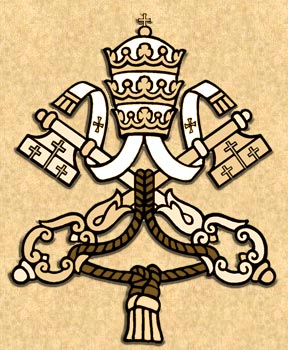Nero's persecution was occasioned by an early morning fire on July 19, 64. It broke out in a small shop by the Circus Maximus and spread rapidly to other regions of Rome, and raged for nine days, destroying much of the city. This was the worst in a series of fires that beset the crowded city -- more than a million people, packed tightly into apartment blocks of wooden construction, among narrow streets and alleyways. Only two areas escaped the fire; one of them, the Transtiberum region, Trastevere, across the Tiber River, had a large Jewish population.
Nero was at his seaside villa in Anzio when the blaze began, but he delayed returning to the city. They say that when he heard the news, he began composing an ode comparing Rome to the burning city of Troy (illustration above). His indifference to the suffering caused by the tragedy stirred resentment among the people. Rumors began that he himself set the fire in order to rebuild the city with his own plans.
Nero To stop the rumors, Nero decided to blame someone else, and he chose a group of renegade Jews called Christians, who had caused trouble before, and already had a bad reputation in the city. Earlier, about the year 49, the Emperor Claudius had banished some of them from Rome for starting upheavals in the Jewish synagogues of the city with their disputes about Christ.
Nero's Raging Sword
"Nero was the first to rage with Caesar's sword against this sect," wrote the early-Christian writer, Tertullian. "To suppress the rumor," the Roman historian Tacitus says, "Nero created scapegoats. He punished with every kind of cruelty the notoriously depraved group known as Christians." Just how long the process went on and how many were killed, the Roman historian does not say.
Christian martyrs of Rome The Early Christians of Rome
Who were the early Roman Christians? Most of them came from the large community of about 50,000 Jewish merchants and slaves who had strong ties to their mother city of Jerusalem. Even before Peter and Paul arrived in Rome, Jewish-Christians, clearly identified as followers of Jesus Christ, were found among the city's Jews. Indeed, these were the founders of the church at Rome; the apostles were among its foundation stones.
By the time of the fire Rome's Jewish-Christians had become alienated from the larger Jewish community and were beginning to separate from it. Where they lived and met was well known. The authorities, following the usual procedure, seized some of them, brought them to the Prefecture and forced them by torture to give the names of others.
"First, Nero had some of the members of this sect arrested. Then, on their information, large numbers were condemned -- not so much for arson, but for their hatred of the human race. Their deaths were made a farce." (Tacitus)
Mass Executions
Instead of executing the Christians immediately at the usual place, Nero executed them publicly in his gardens nearby and in the circus. "Mockery of every sort accompanied their deaths. Covered with the skins of beasts, they were torn by dogs and perished, or were nailed to crosses, or were doomed to the flames and burnt, to serve as a nightly illumination, when daylight had expired." (Tacitus)
Most thought Nero went too far. "There arose in the people a sense of pity. For it was felt that they (the Christians) were being sacrificed for one man's brutality rather than to the public interest." (Tacitus)
Evil triumphs when good men do nothing - Edmund Burke
Tuesday, June 30, 2009
Subscribe to:
Post Comments (Atom)









No comments:
Post a Comment